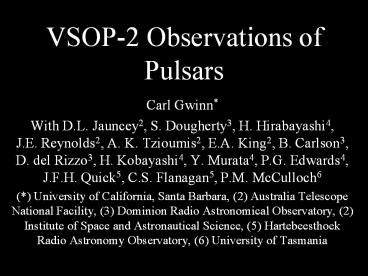VSOP-2 Observations of Pulsars PowerPoint PPT Presentation
Title: VSOP-2 Observations of Pulsars
1
VSOP-2 Observations of Pulsars
- Carl Gwinn
- With D.L. Jauncey2, S. Dougherty3,
H. Hirabayashi4, J.E. Reynolds2, A. K. Tzioumis2,
E.A. King2, B. Carlson3, D. del Rizzo3, H.
Kobayashi4, Y. Murata4, P.G. Edwards4, J.F.H.
Quick5, C.S. Flanagan5, P.M. McCulloch6 - () University of California, Santa Barbara, (2)
Australia Telescope National Facility, (3)
Dominion Radio Astronomical Observatory, (2)
Institute of Space and Astronautical Science, (5)
Hartebeesthoek Radio Astronomy Observatory, (6)
University of Tasmania
2
Why VLBI of Pulsars?
- Astrometry
- Parallax
- Proper Motion
- Cosmological Rotation
- Scattering
- Interstellar Plasma Turbulence
- Structure of Radio Pulsar Emission Region
3
VLBI of Pulsars with VSOP-2
- Pulsars are hard to observe
- Weak at llt20 cm
- Pulsed emission
- Flux density varies
- Gating can increase SNR
- Scintillation complicates spectra
- Noise can be important
4
AstrometryCosmological Rotation
The local inertial reference frame is also the
reference frame of the distant galaxies. This
isnt the case for all model universes that are
consistent with General Relativity. Relative
rotation of the frames can be measured using
pulsar VLBI as an intermediary between the frames.
5
A room contains an ensemble of rotating, elastic
spheres. All have equatorial bulges except one.
It is perfectly round. That one is at rest,
relative to the distant galaxies. -- Sciama, The
Physical Foundations of General Relativity
6
The Solar System acts as a gyroscope, with
accurately-measured motions, understood via
Classical Mechanics in an inertial,
nonrotating reference frame. Timing of pulsars
yields their proper motions in that frame.
7
VLBI yields proper motions of pulsars in the
frame of distant quasars.
Comparison of proper motions from pulsar-timing
with those from VLBI gives the relative rotation
of local and cosmological frames.
Star map by John Flamsteed, Linda Hall Library
8
Some Numbers PSR 0437-4715
- Flux density
- 8 GHz 16 mJy
- 22 GHz 2 mJy
- Gain in SNR from Pulsar Gating ?2.5
- Accuracy of timing proper motion 10 mas/yr
9
ScatteringStructure of Pulsar Emission Region
Scattering of radio waves in the interstellar
plasma acts as a large, but very corrupt,
lens. This lens has a nominal resolution of about
l/D100s of km, for some pulsars. Pulsar VLBI
allows measurement of the size of the emission
region, if it is about this size.
10
Pulsars are Small
Radio emission region300 kmNeutron star15 km
11
Scintillation Light Traveling Along Different
Paths Interferes, and the Speckle Pattern Sweeps
Past Earth
Scotch tape
The observed pattern changes with time, and
observing frequency.
12
Speckle pattern depends on source position. Two
sources (coded by stripes) produce different
speckle patterns.
Interstellar Plasma
Statistics of the observed pattern give source
size.
13
Vela Pulsar
- Size measurement works best for the Vela Pulsar
heavily scattered, strong enough to detect in
1 scintillation time?1 scintillation bandwidth - 3 Important Things
- Distribution of Visibility (including source size
effects) - Distribution of Noise
- Speedy Fit of model to observations
14
FitVSOP1
- Calculate model visibility distribution
(including source size or none) - Add noise not a convolution
- Project to 1D number N(ReV), mean square ImV
- Nonlinear fit to data
VSOP-1 to Tidbinbilla, Gate 1
101
11
15
Distribution of Visibility for a Scintillating
Point Source
Short Baseline
Long Baseline
Zero Baseline
For 0 baseline, the distribution of visibility is
exponential along ReV (distribution of
intensity for a single dish). As the baseline
lengthens, the distribution broadens in
ImV. For long baselines, the distribution is
circular (phase is random).
Interferometric Visibility of a Scintillating
Source ApJ 2001, 1197
16
Effects of Source StructureNoise
Resolved source
Point source
Resolved source
Point source
Probability
No Noise
With Noise (as Measured)
If the source is resolved, the peak is softer,
and shifted toward ReV the
distribution is wider in ImV. Added
instrumental and source noise, soften the peak
and widen the distribution, but the centroid
remains near 0.
17
Distribution of Noise
Noise includes source noise (self-noise), which
changes with intensity and visbility And sky,
instrumental, and other noise, which dont.
VSOP-1 - Tidbinbilla baseline
Mopra-Tidbinbilla baseline
- We assess all of the noise by comparing samples
within one element of the scintillation pattern. - Excellent correlator design and performance are
critical for stable and understandable noise.
18
VSOP-2 Observations
- Resolution is lower at shorter wavelength
- Scale of scintillation pattern 104 km
- Scintillation Time x Bandwidth at 8 GHz
- 9 MHz x 45 sec
- Pulsar flux density is 0.13 Jy (no gating)
- SNR 5 in 1 scintillation element on VSOP-2 to
Tidbinbilla Baseline - 5x better with pulsar gating
19
Summary
- Pulsar VLBI is hard
- The results can sometimes be interesting
- VSOP-2 can make some interesting pulsar
observations - This requires
- High-sensitivity observations big antennas!
- Pulsar gate would help
- Control of noise at the correlator
- Lots of work by investigators

